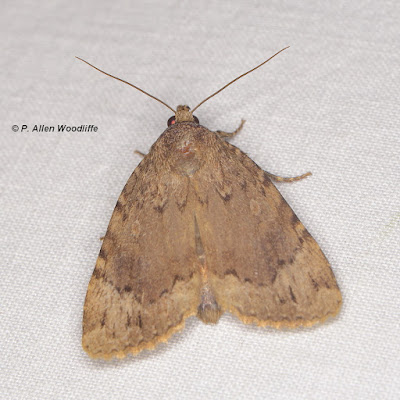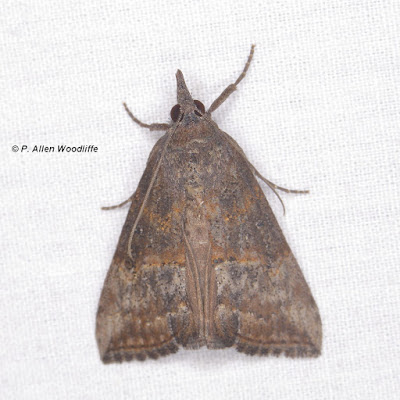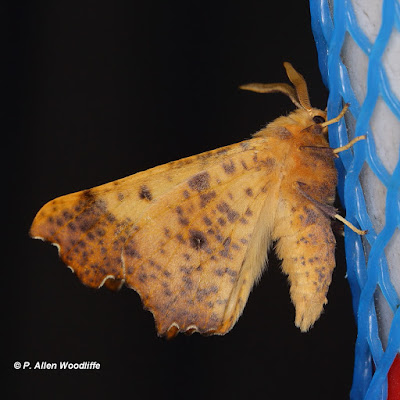I've been doing a lot more black lighting lately. Regular readers may have noticed. It is a different kind of nature photography, certainly emphasizing the macro end of things but rewarding just the same. It takes a fair bit of patience not only to set things up and attract critters, but to get good enough photos which can hopefully be identified since a lot of the subjects are relatively less known.
I recently had the opportunity to set up and photograph night time creatures at Newport Forest, in Elgin County. I don't know all the background of Newport Forest, but a few years ago two people, Kee and Pat Dewdney of London, purchased it with the intention of conserving and restoring it. It was a mix of forest, floodplain, creek systems and former agricultural land along the south side of the Thames River. On the former agricultural lands, many native trees and shrubs have been planted and are now thriving amidst the old field vegetation. Not only was the intent to conserve and restore it, but to do as complete an inventory as possible of all life forms they and others could discover.
In more recent years, the property has been transferred to the Thames Talbot Land Trust, an amazing group of volunteers which has acquired several properties in Middlesex and adjacent counties with the goal of preserving and protecting the natural features occurring on them.
Using black lighting enables one to attract creatures that may otherwise be difficult to inventory for. Kee Dewdney has set up a black light on several occasions in the past few years, and I was fortunate to join him a few evenings ago with my own black light equipment, hoping to increase the list of species, or at least getting some good photos of species already known for the site.
Not everything that we captured by black light has been identified down to the species level, so it is uncertain at this stage just how many of the creatures we documented are in fact new. Kee puts out a periodical bulletin to interested people which summarizes the latest findings and activities on site. My post here is not intended to usurp Kee's report, but to share some of the photos that I obtained.
Many types of creatures are attracted to lights...moths, beetles, orthoptera, flies, bugs, etc. Even though October is not the most productive time for black lighting, it can still fill in some gaps. A bonus is that the mosquitoes aren't much of a nuisance.
Beetles, and in particular leafhoppers, are interesting but challenging to photograph due in part to their very small size, some of which are a mere 3 mm in total length. Against a white sheet, they all look black and it isn't until one gets a bright light on them and a good close-up photo that you can see the various patterns. There are hundreds of species, making them one of the more difficult groups to identify. Many of them don't have common names.
 |
| Bandara sp |
 |
| Gyponana octolineata |
 |
| Jikradia olitoria |
 |
| Prescottia lobata |
 |
| Texananus sp |
Related to the leafhoppers are the planthoppers. This next one is a member of the Flatidae family, known as
Flatormenis proxima.
A type of Plant Bug is this next one, in the Miridae family.
 |
| Lygus sp |
Next is a spittlebug, the nymphs of which can be found in the frothy spittle like substance found on vegetation. This photo is of an adult, only about 3 mm in length.
 |
| Clastoptera obtusa |
Crickets, grasshoppers and katydids are fairly abundant in these habitats, but don't often come to lights. This next one is a Two-spotted Tree Cricket, one of the more distinctive members of the Orthoptera in the area. I believe this first one is a female with both a side view and a top view. The third photo is of another Two-spotted Tree Cricket showing the variable pattern on the top side.
 |
| Neoxabea bipunctata |
Crane Flies are relatively large creatures, looking a bit like a giant mosquito. This one has not been confirmed as to species, but is likely
Tipula sayi.
Caddisflies are numerous, and often difficult to identify to species unless they are collected.
Moths are one of the larger groups of night time creatures that visit black lights. Here are some of those that had the best photos turn out.
 |
| Clandestine Dart Spaelotis clandestina |
 |
| Common Idia Idia aemula |
 |
| Common Tan Weave Pleuroprucha insulsaria |
 |
| Copper Underwing Amphipyra pyramidoides |
 |
| Diamondback Epinotia Epinotia lindana |
 |
| Pale-spotted Palthis Palthis asopialis |
 |
| Green Cloverworm Hypena scabra |
 |
| Maple Spanworm Ennomos magnaria |
 |
| The Wedgeling Galgula partita |
 |
| Spotted Grass Moth Rivula propinqualis |
Although the black lighting season is winding down, there may yet be opportunities to see what is still around at the end of the season.
























Quite remarkable photos. We have a lot of Crane Flies attracted in through the bathroom window. They most often become entangled in the Daddy-Long-Leg Spider webs. We have resident spiders all over the house. The bathroom 3 are named Thomas, Richard and Henry. Richard and Henry take it in turns to travel for a few days, but always return. Perhaps Thomas is Thomasina! Every now and then we remove all the spiders and put them in the garden, except the 3 in the bathroom.
ReplyDeleteHi Paula...thanks for the comments. That is amusing about naming your eight-legged bathroom residents. Do they come when they are called?
Delete